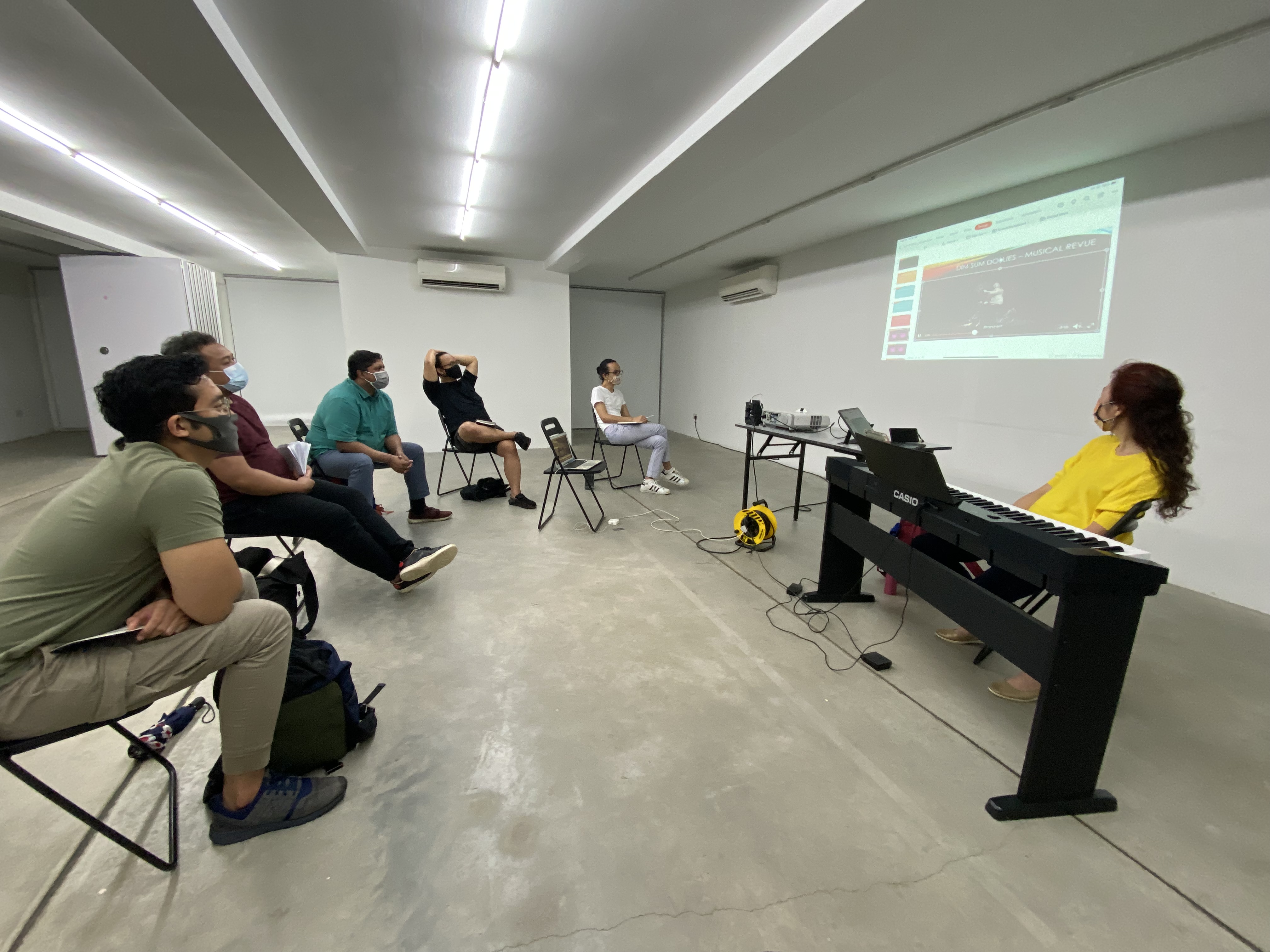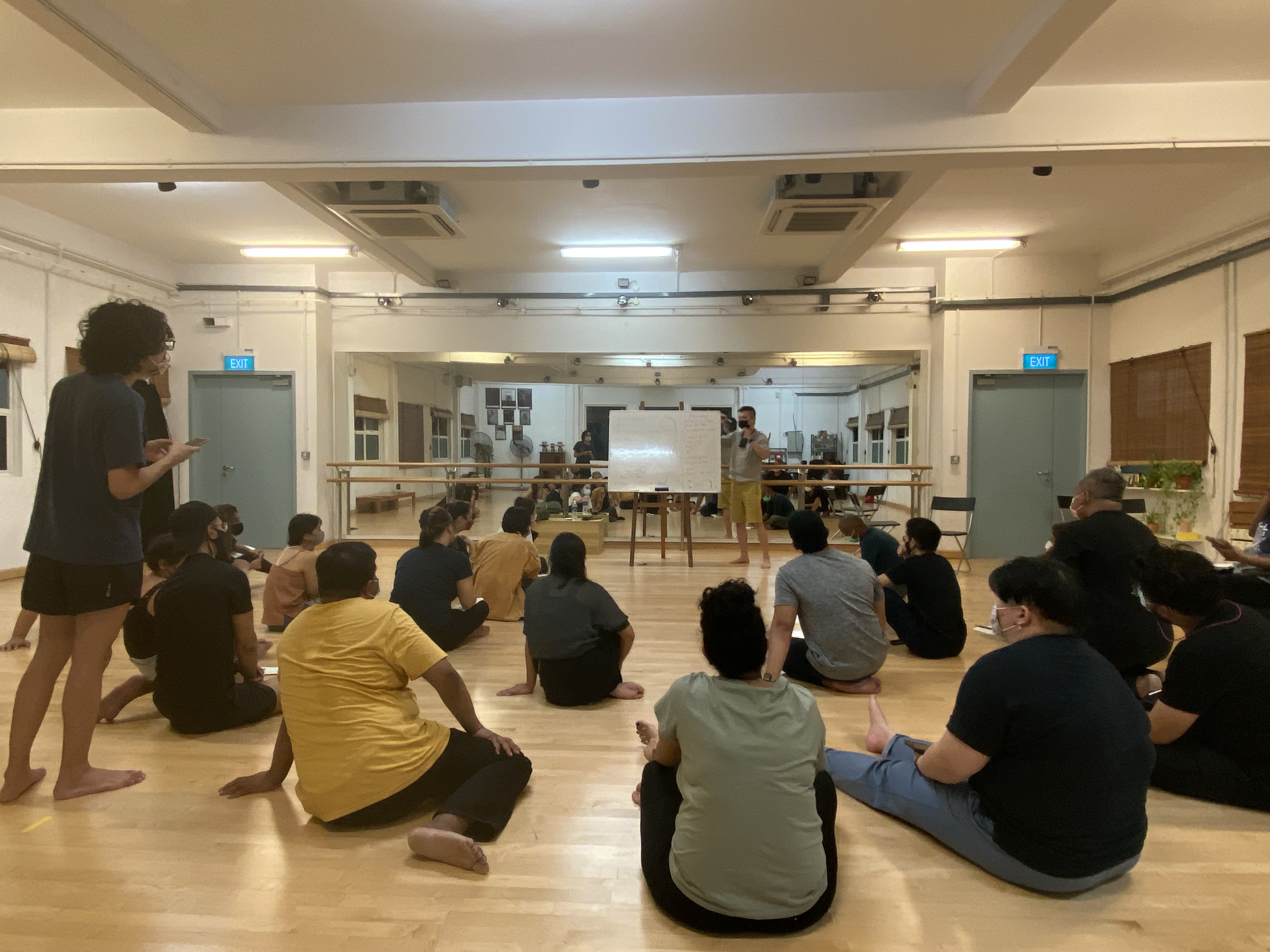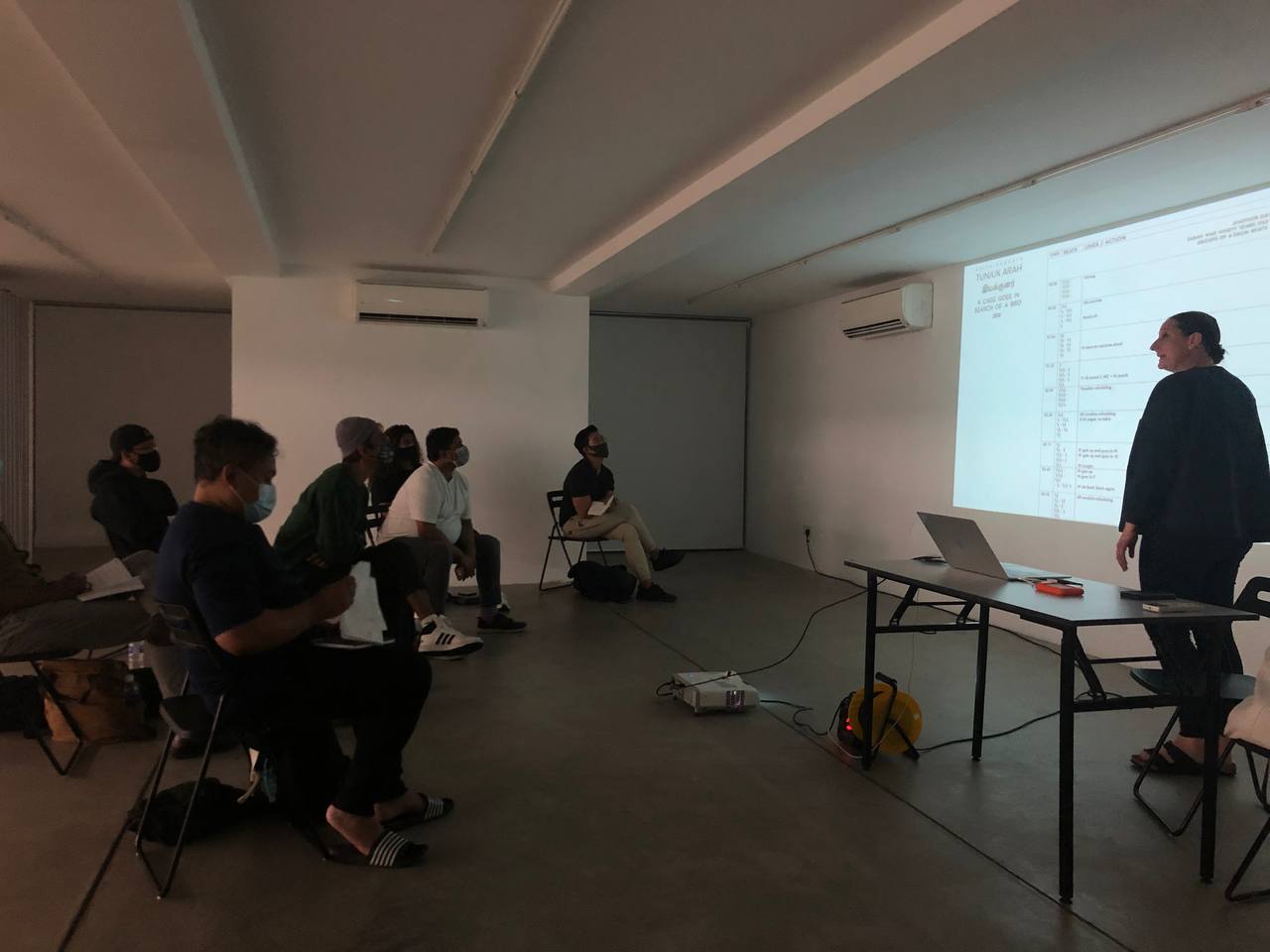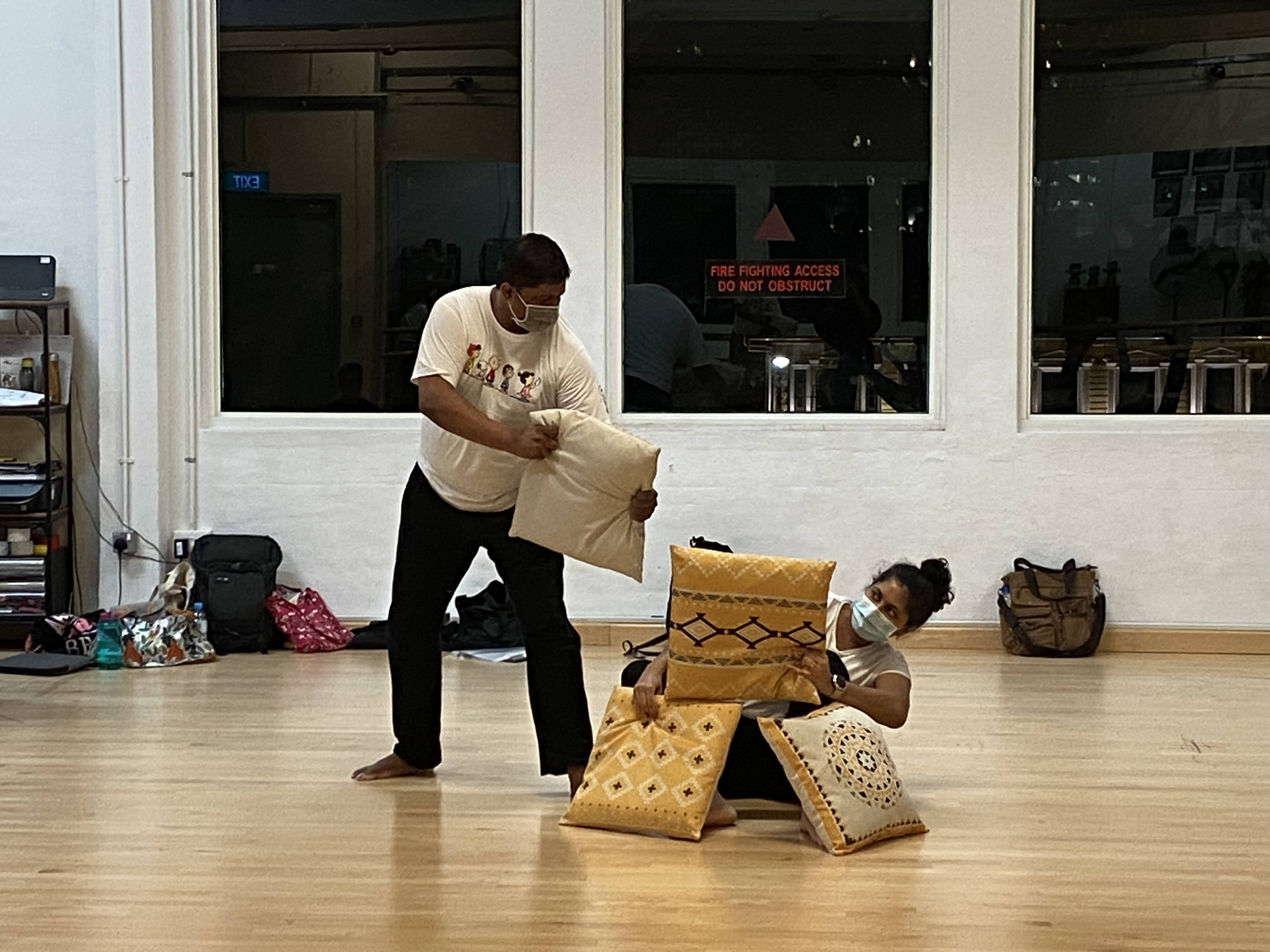Tunjuk Arah/ இயக்குனர் workshop with Elaine Chan. Photograph by Fezhah Maznan / Tunjuk Arah/இயக்குனர் team.

Created and produced by Fezhah Maznan with the support from the National Arts Council, Tunjuk Arah/ இயக்குனர், is a developmental programme for young and experienced directors to reflect on their practice and grow and be groomed by various local and regional directors in a structured learning environment.
Under the mentorship of Edith Podesta and masterclasses by Theatre practitioners in the industry, the programme hoped to develop a group of directors who are able to direct engaging and affective works in Malay and Tamil languages, apply good directorial strategies and demonstrate confidence in developing and maturing their directorial identity.
The masterclasses and sharing sessions held from Dec 2021 - Feb 2022, will culminate with a 20-min dramatized reading or theatrical essay of a Singapore Malay or Tamil play by the participants in March 2022, supported by Teater Ekamatra and Centre 42.
Brown Voices member, Hemang Yadav, was one of the participants in this programme. A little chat to find out how it had helped him.
1. What are some of the key points you have taken back from the programme?
I have learnt the importance of preparation – of the amount of preparatory work a director actually has to do even before entering the rehearsal space. I have also learnt about navigating collaboration and leadership, which might very well be the most vital skill a director has to develop. At the same time, I attained affirmation for many methods and processes I had personally tried as a director on my own, as I discovered that many of these methods were frequently used by well-established directors as well.
2. How different was this programme from other directing workshops?
The biggest difference was the fact that this was more like a series of masterclasses rather than a singular workshop. Directing workshops I had attended previously tend to be exemplars of a particular methodology or school of thought. Here, however, we were exposed to multiple practitioners with very different practices and theoretical backgrounds. This made this particular ‘workshop’ rich and helped me figure out a methodology that works for me, given my own directorial interests and inclinations.

Photograph of Tunjuk Arah/ இயக்குனர் workshop with Chong Tze Chien.
3. Was there a unique learning curve due to it being just for Indian and Malay participants? Or was it a restricted learning curve?
Surprisingly, it seemed to matter very little! While the participants were Indian and Malay theatre practitioners, it was clear that practically all of us were familiar with English speaking theatre and had dabbled in it, so language, race or culture did not really matter or interfere in what we were learning or discussing about. The kinds of theatre each one of us has been involved in or was interested in was far more divergent than one might expect from theatre practitioners of a particular language. Perhaps there was a greater willingness to question status quo and a heightened awareness of marginality that did inform our questions and discussions, but on the whole the workshop reiterates the importance of not dividing or ghettoising theatre based on language.
4. Can you highlight any particular masterclass/ talk that you enjoyed and/or benefitted the most from?
I particularly enjoyed Kaylene Tan’s masterclass about audio-plays. I was the dramaturg for a very successful audio play (Drama Box’s Chinatown Crossings) and have written and worked as a voice actor for two audio plays by Brown Voices (Vel Vel and Little India Foodsteps). Nonetheless, I would not say I have truly worked on an audio play before. Kaylene’s sharing was very intriguing and refreshing. It has sparked a new interest in me in exploring this particular form, or perhaps to see if hybrids can be created by incorporating elements of the audio play in a ‘normal’ play. With the endemic pandemic, we need to explore alternatives like this.
5. How has the programme changed/shaped your playwriting thoughts and process?
Some of the processes of ideation and creation of theatre pieces have heightened my interest in utilising actor improvisation to generate a text or script. I have also developed a greater awareness of the needs of a director – both clarity (so they can understand the intentions of the playwright) as well as openness (so the director can bring in their own vision or touch to the production). This would naturally affect the way I write, for I now write not just with the audience in mind, but also the director who will one day take up my script in order to stage it.

Photograph of Tunjuk Arah/ இயக்குனர் workshop with Edith Podesta.
6. Would it be easier being both the playwright and director in a show or should the roles be split and done by two individuals? Why?
It would indeed be easier to take on both the roles of playwright and director – the director can change the text during rehearsal without worrying about being respectful to the text or insulting the playwright, since he or she wrote it in the first place. Also, the director is automatically privy to the intentions of the playwright, without tedious examination of the script or equally tedious conversations with the playwright. The playwright too has an easier job writing the script, without worrying too much about having to make intentions very clear.
However, I would still recommend that the roles be split. On the one hand, it encourages the playwright to write in a way that might allow the script to live on, so that years later a director might pick it up and get it enough to want to direct it. On the other hand, the director can enrich the production by bringing in a fresh perspective. Two heads are better than one.
7. How did you benefit from the mentorship in this programme? Did it help with your practice?
Edith Podesta’s mentorship was very helpful in giving me a very focused way of looking at the art of directing. It gave me a new perspective of how a director helms a production from the place of a team-leader, and how a ‘director prepares’, rather in the style of Stanislavsky’s ‘An Actor Prepares’. I have always believed in collaboration, but I have now learnt how to temper collaboration with leadership, and how important that actually is for the successful running of the rehearsal process as well as the success of the eventual production.

Photograph of Tunjuk Arah/ இயக்குனர் workshop with Koh Wan Ching.
8. What would you be working on for your 20mins presentation and how different is the process from your previous works?
I will be working on a radio play written by my late grandfather Mr N. Palanivelu titled Rishyashringa. I usually work with mythology and this play is based on a myth as well. The play deals with a young celibate, Rishyashringa, who has been brought up by his ascetic father with no knowledge about the existence of females, and what happens when a woman disguises herself as a man to seduce him and trick him into eloping from the forest to the kingdom, as only the entrance of a true celibate will bring rain to the land suffering from drought. The play explores the topic of power through binaries like plenitude and scarcity, nature and civilisation and most importantly femininity and masculinity.
My process for this will be radically different from what I usually do. I’m creating a theatrical essay rather than working on a fixed script. I will be doing a lot of devising and improvisations to compose the text, based on what already exists as well as work created by the actors. I will also be using the 22 ingredients or compositions suggested by Ann Bogart.
9. Why would you recommend other playwrights to attend a director’s workshop if one is available to them?
Firstly, the more knowledge a playwright has about the various production elements that are necessary for the play to get to its final form as a staged production, the more stageable the script tends to be. So knowing the director’s craft (and even the actor’s, or the designer’s) would undoubtedly help the writing process.
Secondly, the directorial possibilities can themselves act as stimuli for writing, leading to new ideas or even presenting a solution for writer’s block.
Thirdly, on a practical level, it gives more job opportunities to theatre practitioners! Even if playwriting is a practitioner’s first love, there is no reason why he or she should not develop a liking and knack for a different role in the theatre.
Published: 23 March 2022